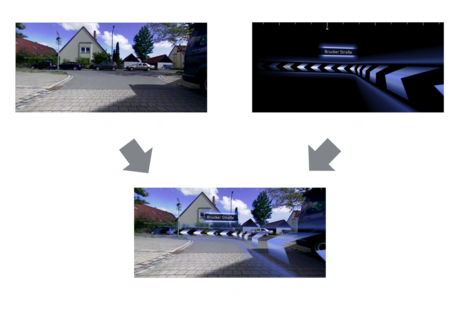Augmented Reality is a computer-assisted process in which additional information in the perceived world is displayed in real time. This augmentation can be realized in a camera image or in the field of vision via a head-up display or semi-transparent glasses. Virtual objects, also known as AR content, are superimposed on the real world. This content can be anything from text and highlighted recognized objects to 3D graphics. The components required for the technical implementation of this process are called AR systems. In most cases, they consist of a camera, some sensors for determining the position of the camera or another camera for determining the eye position, a display medium and the software.
A distinction is often made between three variants of AR: marker-based, markerless and geo-based. In the marker-based version, a marker, such as a QR code recognized by the camera, serves as a trigger for displaying virtual content. The detected marker can also be used for positioning and has the advantage that the virtual object can be positioned in a stable manner at a location in the real world.
When working without markers, pattern recognition is often used to detect certain structures or objects. The identification of these structures or objects triggers the display of information. The geo-based variant uses the location position to display corresponding AR content. Additional sensors for gyroscopic or acceleration data are required for stable placement of the content in the environment.
Whether used as a real-time camera image to help navigate at blind intersections or as a head-up display to mark the vehicle ahead, AR is certain to enrich our driving experience in the future. Here at e.solutions, we are busy researching and working on this topic.
AR technology is already supporting drivers with additional information in the camera images when parking. The “Topview” parking system, for example, displays distance information on detected objects. The lane of the tires is displayed in the front and rear camera images. There are even vehicles with night vision cameras that show colored borders around pedestrians or animals detected in the image. Audi’s digital matrix light system can also be understood as an AR application. This makes it possible, for example, to use the car’s lighting system to highlight the boundaries of the road or to separately illuminate recognized pedestrians.
e.solutions has a dedicated team working on the topic of augmented reality and its application in vehicles. Within the scope of a pre-development project, we have been working on a camera-based augmented reality navigation support system and have developed a complete in-house solution, “KARL”. KARL stands for camera and AR solution and is a library containing the most important functions for the realization of AR in cars. These include, for example, the function of the vehicle’s pitch-roll compensation to enable the display of stabilized AR content.
KARL has been tested and proven on both near-series hardware and in the KARL studio. The KARL studio is a self-developed simulation environment for desktop computers, which serves to visualize content from the perspective of the AR observer. It is highly versatile and can be easily extended with plug-ins.
